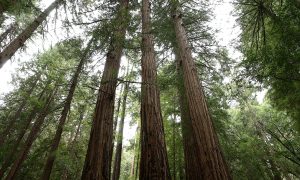Scientists Studying Tree Rings Say ‘Radiation Storms’ Not Caused by Solar Flares as Previously Thought
A team of scientists at the University of Queensland in Australia have turned to trees in an effort to discover more about mysterious and potentially devastating radioactive space storms that have hit earth several times over the past 10,000 years.The team of researchers included an undergraduate student and was led by Benjamin Pope from the University of Queensland’s School of Mathematics and Physics. They analyzed the rings from millennia-old trees. The researchers say radiation storms—known as Miyake events after the Japanese scientist who discovered them—have occurred approximately once every thousand years and prompt energetic spikes in Earth’s radiation level. In total, six Miyake events have been reliably identified in data taken from tree rings and analyzed, occurring in 7176 BCE, 5410 BCE, 5259 BCE, 660 BCE, 774 CE, and 993 CE. However, researchers still don’t know what causes them or how to predict their occurrence, and the events could have devastating effects on earth. “The leading theory is that they are huge solar flares,” Pope said in a press release about the study. “We need to know more because if one of these happened today, it would destroy technology including satellites, internet cables, long-distance power lines, and transformers. The effect on global infrastructure would be unimaginable.” ‘These Odds Are Quite Alarming’ When the events occur, radiation strikes the atmosphere and produces carbon-14, a radioactive isotope of carbon that is rare to find when compared to nonradioactive carbon. Carbon-14 then gets filtered out through the air, oceans, plants, and animals, and produces an annual record of radiation in tree rings. Researchers decided to turn to those tree rings in an effort to analyze data on the historical cosmic events. “We modeled the global carbon cycle to reconstruct the process over a 10,000-year period, to gain insight into the scale and nature of the Miyake Events,” said Qingyuan Zhang, an undergraduate math student at Queensland University who developed the software to analyze the tree rings. The researchers said they found the timing of the solar flares was inconsistent with the duration of the radiation events. “We’ve shown they’re not correlated with sunspot activity, and some actually last one or two years,” Zhang said. “Rather than a single instantaneous explosion or flare, what we may be looking at is a kind of astrophysical ‘storm’ or outburst.” The research was published in Proceedings of the Royal Society A: Mathematical Physical and Engineering Sciences on Oct. 26 (pdf). Scientists have said that based on the current data, there’s roughly a 1 percent chance of seeing another Miyake event within the next decade. “We don’t know how to predict it or what harms it may cause,” Zhang said. “These odds are quite alarming, and lay the foundation for further research.” Follow Katabella Roberts is a news writer for The Epoch Times, focusing primarily on the United States, world, and business news.

A team of scientists at the University of Queensland in Australia have turned to trees in an effort to discover more about mysterious and potentially devastating radioactive space storms that have hit earth several times over the past 10,000 years.
The team of researchers included an undergraduate student and was led by Benjamin Pope from the University of Queensland’s School of Mathematics and Physics. They analyzed the rings from millennia-old trees.
The researchers say radiation storms—known as Miyake events after the Japanese scientist who discovered them—have occurred approximately once every thousand years and prompt energetic spikes in Earth’s radiation level.
In total, six Miyake events have been reliably identified in data taken from tree rings and analyzed, occurring in 7176 BCE, 5410 BCE, 5259 BCE, 660 BCE, 774 CE, and 993 CE.
However, researchers still don’t know what causes them or how to predict their occurrence, and the events could have devastating effects on earth.
“The leading theory is that they are huge solar flares,” Pope said in a press release about the study. “We need to know more because if one of these happened today, it would destroy technology including satellites, internet cables, long-distance power lines, and transformers. The effect on global infrastructure would be unimaginable.”
‘These Odds Are Quite Alarming’
When the events occur, radiation strikes the atmosphere and produces carbon-14, a radioactive isotope of carbon that is rare to find when compared to nonradioactive carbon.
Carbon-14 then gets filtered out through the air, oceans, plants, and animals, and produces an annual record of radiation in tree rings.
Researchers decided to turn to those tree rings in an effort to analyze data on the historical cosmic events.
“We modeled the global carbon cycle to reconstruct the process over a 10,000-year period, to gain insight into the scale and nature of the Miyake Events,” said Qingyuan Zhang, an undergraduate math student at Queensland University who developed the software to analyze the tree rings.
The researchers said they found the timing of the solar flares was inconsistent with the duration of the radiation events.
“We’ve shown they’re not correlated with sunspot activity, and some actually last one or two years,” Zhang said. “Rather than a single instantaneous explosion or flare, what we may be looking at is a kind of astrophysical ‘storm’ or outburst.”
The research was published in Proceedings of the Royal Society A: Mathematical Physical and Engineering Sciences on Oct. 26 (pdf). Scientists have said that based on the current data, there’s roughly a 1 percent chance of seeing another Miyake event within the next decade.
“We don’t know how to predict it or what harms it may cause,” Zhang said. “These odds are quite alarming, and lay the foundation for further research.”












